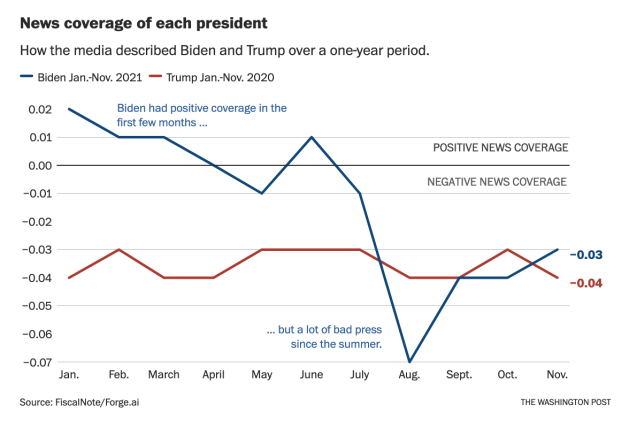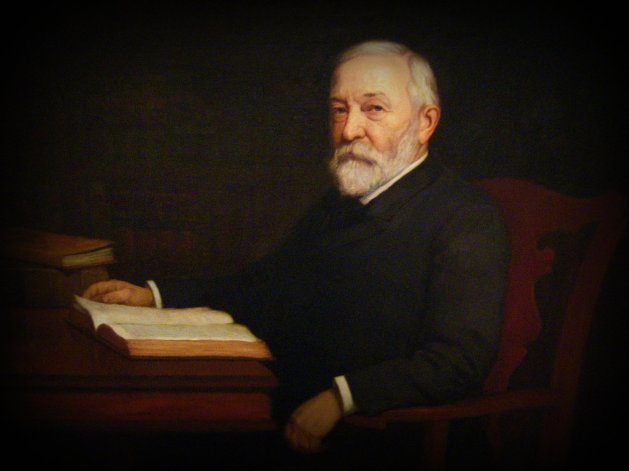
Previously published at GBH News.
One president lied about COVID-19 (the country’s and his own), embraced white supremacists and tried to overturn the results of an election that he lost. Another president has hit a few bumps in the road as he attempts to persuade Congress to pass his agenda. Can you guess which one received more negative news coverage?
If you guessed President Joe Biden, then come on down. According to an analysis of 65 news websites, Biden’s treatment by the media was as harsh or harsher from August through November of this year than then-President Donald Trump’s was during the same four-month period in 2020.
On one level, it’s inconceivable. On another, though, it’s all too predictable. Large swaths of the media simply cannot or will not move beyond both-sides journalism, equating the frustratingly hapless Democrats with a Republican Party that has embraced authoritarianism and voter suppression.
“My colleagues in the media are serving as accessories to the murder of democracy,” wrote Washington Post columnist Dana Milbank, who ordered up the study. He concluded: “Too many journalists are caught in a mindless neutrality between democracy and its saboteurs, between fact and fiction. It’s time to take a stand.”
As I’ve written before, and as many others have said, we’re in the midst of a crisis of democracy. The Republican Party, already disproportionately empowered because of the Constitution’s small-state bias and the Senate filibuster (the latter, of course, could be abolished tomorrow), is working to strengthen its advantage through partisan gerrymandering and the passage of voter-suppression laws. The result could be white minority rule for years to come.
The situation has deteriorated to the point that the European think tank International IDEA now regards the United States as a “backsliding democracy.” To quote from IDEA’s report directly, “the United States, the bastion of global democracy, fell victim to authoritarian tendencies itself, and was knocked down a significant number of steps on the democratic scale.”
And the media remain wedded to their old tropes, covering political campaigns as though they were horse races and treating the two major parties as equally legitimate players with different views.
It’s a topic that was discussed at length recently on Ezra Klein’s New York Times podcast by New York University journalism professor Jay Rosen and guest host Nicole Hemmer, a scholar who studies right-wing media. Their conversation defies easy summary (the whole episode can be found here), but essentially, Rosen argued that the political press falls back on its old habits because breaking out of them is just too difficult.
“The horse race absorbs a lot of abuse from people like me,” he said. “But it can take that abuse, because it is such a problem-solver. It checks so many other boxes that even when people know it’s kind of bankrupt, it stays on.” As an alternative, Rosen proposes coverage based on a “citizens agenda,” which he has written about at his blog, PressThink. But he admitted to Hemmer that we may lose our democracy before his ideas are adopted by more than a fraction of journalists.
What I find especially frustrating is that the media have not been ignoring the Republican threat to our democracy. Far from it. As just one small example, the Times on Sunday published a front-page story by Nick Corasaniti on a multitude of actions being taken at the state level to suppress the vote and put Trump loyalists in charge of the election machinery.
“Democrats and voting rights groups say some of the Republican measures will suppress voting, especially by people of color,” Corasaniti wrote. “They warn that other bills will increase the influence of politicians and other partisans in what had been relatively routine election administration. Some measures, they argue, raise the prospect of elections being thrown into chaos or even overturned.”
So why am I frustrated? Because this sort of valuable enterprise reporting is walled off from day-to-day political coverage. We are routinely served up stories about the congressional Republican leaders, Rep. Kevin McCarthy and Sen. Mitch McConnell, going about their business as though they were latter-day versions of the late Bob Dole, sharply partisan but ultimately dedicated to the business of seeking compromise and governing. In fact, whether through cowardice or conviction, they are enabling our slide into authoritarianism by undermining the investigation into the Jan. 6 insurrection as well as by failing to call out Trump and the excesses of their worst members.
Earlier this year, Washington Post columnist Margaret Sullivan endorsed the idea of a “democracy beat,” which would look closely at attempts to subvert voting rights. Sullivan would go further than that, too. “The democracy beat shouldn’t be some kind of specialized innovation,” she wrote, “but a widespread rethinking across the mainstream media,” permeating every aspect of political and governmental coverage.
If Trump runs again, he may very well end up being installed as president even if he loses both the popular vote and the Electoral College. Who would stop him? In the aftermath of the 2020 election, there were still enough Republican state and local officials with integrity who refused to go along with Trump’s demands that they overturn the results. That is not likely to be the case in 2024. As Barton Gellman wrote in a new Atlantic cover story, “The prospect of this democratic collapse is not remote. People with the motive to make it happen are manufacturing the means. Given the opportunity, they will act. They are acting already.”
Meanwhile, the media go about covering President Biden and his travails as though our politics hadn’t changed over the past 40 years. Of course Biden needs to be held accountable. The ugly withdrawal from Afghanistan, confusing White House messaging about COVID and his inability to bring Sens. Joe Manchin and Kyrsten Sinema to heel are all worthy of tough coverage. (But not inflation because, please, don’t be stupid.) But it needs to be done in a way that we don’t lose sight of the big picture. And the big picture is that we are in real danger of losing our country.
As the Dartmouth political scientist Brendan Nyhan put it on Twitter, “The problem is the media failing to distinguish threats to democracy from normal negative coverage (an important form of democratic accountability!).”
Five years ago Thomas Patterson of the Harvard Kennedy School issued a report showing that coverage of Trump and Hillary Clinton during the 2016 general-election campaign had been equally negative — a finding that he found disturbing. Patterson wrote that “indiscriminate criticism has the effect of blurring important distinctions. Were the allegations surrounding Clinton of the same order of magnitude as those surrounding Trump? It’s a question that journalists made no serious effort to answer during the 2016 campaign. They reported all the ugly stuff they could find, and left it to the voters to decide what to make of it.”
Well, here we go again. Next time, though, it’s the future of democracy that is likely to be at stake.








